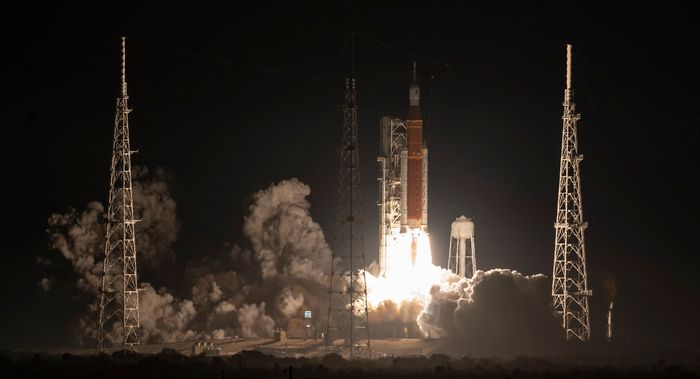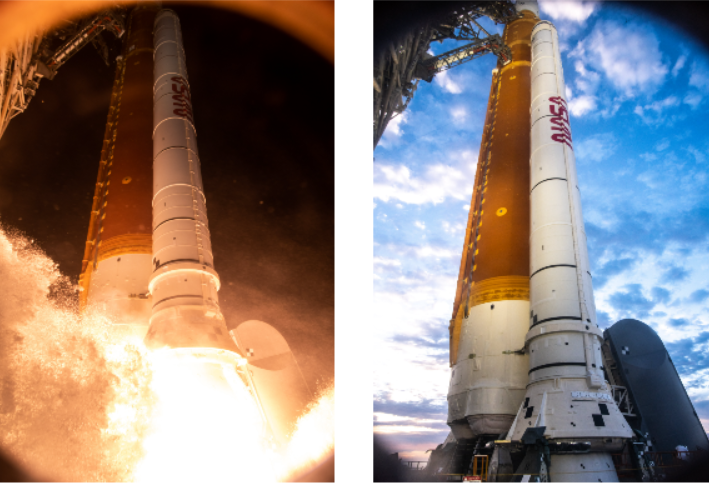Artemis 1 Youtube Live
16th November

@Nasa
November 2022: the month of Artemis! How exciting to see the launch being confirmed and the mission finally running! Of course, we could not miss such an event and we have arranged a livestream especially for the occasion. The live Youtube stream was hosted on the official Space Renaissance International Channel. Several experts spoke during the live stream to share technical knowledge and updates on Artemis 1 with our Lunex and Space Renaissance communities. Did you miss the live stream? Don't worry, you can watch it again here! And if you're wondering how the Artemis mission is going, then read on! Our Rocket Expert Rok Kete, now in Florida, has prepared a short report for us. Enjoy

-R. Kete
Five years after the initially predicted launch date and less than a week after weathering out hurricane Nicole on the launchpad, the Space Launch System (SLS) rocket was ready for its 3rd launch attempt on November 16th. Mission Control (MC) initiated the launch countdown sequence 47 hours before the opening of the launch window. For the most part the launch countdown was uneventful. Tweaks in the propellant loading times and rates that were implemented after two previous scrubbed launch attempts worked. As the MC switched from the tanking mode to the replenish mode, sensors on the Mobile Launch Platform (MLP) detected an issue with one of the valves on the Liquid Hydrogen (LH2) Supply System. To fix the issue a Red Crew was dispatched to the Launchpad. Red Crew discovered the cause of the issue and tightened bolts around the valve. In this time another problem with a range tracking radar was discovered. After a broken Ethernet port was replaced, all systems were "go" for launch. Issues delayed the launch for just over 40 min, but the launch window for that day was 2 hours long. At t-11 min the Launch Director (LD) gave a final ''go'' for launching the vehicle. At t-10 min SLS entered a Terminal Countdown Sequence. Onboard avionics took control over the launch vehicle. Rocket and payloads switched to the internal power. Propellant tanks were topped and pressurized for flight.
At-7 sec, 4 RS-25 engines that flew on the Space Shuttle Missions ignited for the final time. As a nod to the STS Program, engines included components that flew on Shuttle Missions from the STS-1 onward. At t-0 a pair of Redesigned Solid Rocket Motors (RSRMs) ignited and SLS started ascending. After blasting the reinforced elevator doors and clearing the MLP, the rocket performed pitch and yaw maneuvers. SLS turned night over the Space Coast into day. CS Engines temporarily throttled down when the rocket passed through the area of maximal dynamic pressure, known as Max-Q. In the first 2 min and 10 sec of the flight the RSRMs provided 85% of the thrust. After their propellant was depleted, they seperated from the launch vehicle and fell in the Atlantic Ocean. CS continued firing until t+8 min 20 sec. After the 2nd Stage (ICPS) separated from the 1st Stage (CS), Orion stretched its wings (solar panels) for the first time. ICPS ignited twice. First burn put the vehicle in a Parking Orbit around the Earth. Second, more than 18 min long burn, inserted the ICPS and Orion in the Trans Lunar Injection (TLI) Orbit. This was the longest burn by the RL-10 engine. Shortly after the burn was completed, Orion separated from the ICPS, followed by 10 CubeSats. After launch LV Performance Data Review showed that SLS performed better than anticipated in both main aspects-the payload capacity and orbit insertion accuracy. A textbook launch of a new rocket. And the beginning of the Artemis 1 Mission.

CONTACT US
Address : Keplerlaan 1, 2201 AZ Noordwijk, The Netherlands
Email : aojohn928@gmail.com

